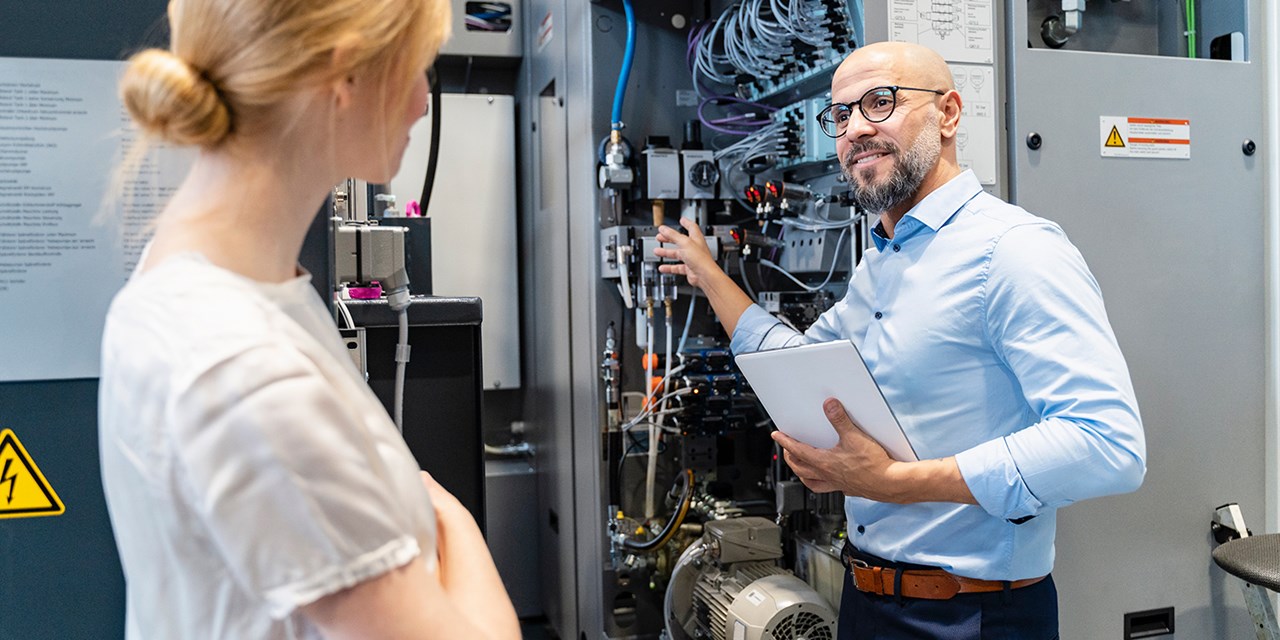Country Selector: Corporate
Let that sink in for a moment, because that has significant implications for every factory and warehouse, both on the work floor and in the back office.

For all work instructions, on-the-job training and workflow solutions, such as breakdown handling, workers want to use the latest digital tools to improve how they work, what suits their location and the nature of their work. Manufacturers who choose the right communication technology will likely see a significant rise in productivity, better on-job learning and improved compliance with new legislation.
As a Presales Engineer, Ascom's own Livane Hellmann knows everything about how the right technology improves operational efficiency. It’s time to ask Livane everything we need to know.
Livane, do you see digital transformation as a solution for improving operational efficiency and creating a better place to work?
“More than 90% of businesses in Europe face challenges from poor digital adoption. Of course, it’s not all about the costs, but also the fear that automating tasks will lead to job losses. I don’t see technology replacing people. Technology will not be used as a way to raise the pressure on people. It’s there to streamline their tasks and improve their productivity.”
The evidence supports this view: unnecessary and tiresome manual processes drain staff time and morale, both in manufacturing and the jobs market in general. A recent Microsoft report found that more than 40% of workers are considering leaving their employer in the next 12 months. Of that, as many as 25% because of the software they are using.”
But we do see many companies implementing all sorts of technology. What do you think is the problem?
“According to Bloomberg, over 80% of employees use software every day. At the same time, over 50% of these employees are unhappy at work due to issues related to this software. Because it often doesn’t make their work easier or it’s too complicated to use. Or it’s constantly breaking down and employees are waiting and waiting and waiting for IT support.
Some systems experience breakdown rates as high as 25%, requiring a quarter of equipment to be sent back to the supplier for repairs. I think reliability is a significant problem. Not just improving people’s ability to do their job, but in many cases, also for their safety.”


How does smarter task management improve job satisfaction?
“Managers have never had so much to manage. Apart from the constant pressure to ensure efficiency and profitability, there is less time and fewer staff to do more and more tasks. Digitizing and automating processes can help relieve this pressure - Increasing efficiency by providing the right people with the right information at the right time. Done well, it can lead to increased job satisfaction, better staff retention and more loyal customers. In short, employees really feel valued and that they are making a real difference.”
Does that mean that every technology implementation works for every company?
“Not every solution is the same. What works for task management in one company is not necessarily the right solution for another. As a company that has over 50 years of experience in task management, Ascom recognizes this more than most.
In the Ascom portfolio, we offer different tailored solutions. So, for example, what we provide for Mars Group, Danone and EDF are all quite different.”
We often hear you say: “Scheduled maintenance is preventative maintenance.” What do you mean with this phrase?
“Don’t believe the cliché ‘if it ain’t broke, don’t fix it’. 90% of mechanical failures are due to preventable problems, avoidable with a good preventative maintenance plan. Utilizing a computerized maintenance management system (CMMS) enables comprehensive tracking of preventive maintenance tasks, offering a centralized digital hub to manage all equipment within your facility and store crucial safety information.
This not only streamlines safety audits but also provides instant access to the complete maintenance history and safety protocols for every equipment item with just a few clicks on a smartphone.”
Ascom believes it’s important to be able to respond quickly to breakdowns. Why?
“The cost of breakdowns are enough to make anyone break down and cry! The world’s largest manufacturers lose €1.5 trillion every year due to machine failure. For a relatively small business, this can amount to €500 for every minute. For larger companies, up to €1 million per hour. Just for a short outage.
Put simply, machines must operate around the clock, every day of the year. Therefore, scheduled maintenance and quick breakdown responses are an absolute must. Well-executed, scheduled maintenance extends the life of operational equipment, improves performance and drastically reduces the number of breakdowns.”
What should we investigate first if we want to improve our breakdown response?
“Simplicity is paramount in such scenarios, yet the integration of diverse systems and software often proves to be a major challenge. With Ascom this isn’t a problem. A key point, when it comes down to breakdown response is our capability to interface with any system. Even if we don’t have the specific integration they need, we have a team of developers who can create such interfaces in no time.”
We hear a lot about trends such as automation and 5G. Which developments do you foresee in the near future?
“Automation will continue to be a driving force for operational efficiency. Empowering organizations to leverage digital tools and services to streamline internal processes and reduce reliance on manual tasks. As customer expectations for swift and dependable support soar, businesses must adapt accordingly.
We were working on a task management feature for a hotel on the French Riviera. They needed a solution that responded as fast as possible for their highly demanding guests. The person at the hotel desk should be able to press a key and forward a customer request within five seconds. Whether it’s for the bar, the restaurant or whatever other service. We delivered.
Furthermore, the potential of 5G connectivity is only just beginning to unfold. This technology promises a wealth of benefits, including more cost-effective location tracking, which will undoubtedly evolve into a comprehensive ecosystem. Ascom remains at the forefront of embracing these advancements, with 5G integration already incorporated into our latest generation of smart devices.”
How do you feel about operational efficiency within your organization? Is there room for improvement in task management? Is scheduled maintenance and breakdown response in good hands? If you have any questions at all, feel free to ask Ascom. We’re always happy to answer your questions and provide professional advice.